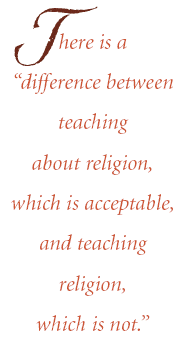Freedom To Speak
November/December 2003
Getting your Trinity Audio player ready...
In 1968 the U.S. Supreme Court ruled in Pickering v. Board of Education that public school teachers do not forfeit their First Amendment rights to engage in speech that their employer, the school district, might find disagreeable.1 The following year, in Tinker v. Des Moines Independent Community School District, the High Court wrote that students and teachers do not "shed their constitutional rights to freedom of speech or expression at the schoolhouse gate."2
These two seminal cases establish that public school teachers, as public employees, do not forfeit all of their First Amendment freedoms when they come to school. One area in which many believe teachers do forfeit their rights to free speech is religious expression. A common perception exists that schools are religion-free zones that teachers must respect.
Jim Henderson, senior counsel with the American Center for Law and Justice, says that "the promise of Tinker finds no fulfillment regarding individual teachers' rights to assert a free-exercise right or a free-speech right to express their religious views against the school district's position that it is entitled to require a teacher to communicate material consistent with the curriculum."3
The free exercise clause of the First Amendment ensures that individuals have a right to practice their religious faith freely. However, public schools are governmental entities that must avoid establishment clause problems. Pupils at school are considered impressionable minors who must be taught academic subjects, not indoctrinated in any religious belief. The tension between the two clauses sometimes surfaces in disputes over teachers' religious expression.
The problem, according to some observers, is a rigid, highly separationist interpretation of the establishment clause that renders any religious expression by teachers constitutionally impermissible and unnecessarily elevates the establishment clause over the free exercise clause. Others counter that schools must protect against religious indoctrination of impressionable young minds to ensure that schools properly protect the individual sphere of liberty and the central meaning of the First Amendment. The often emotionally charged debate over the appropriate balance in this area has led to protests, divided communities, and, frequently, lawsuits.
Why Limit Teachers' Expression
School districts limit teachers' religious expression in order to avoid the perception that the school is endorsing religion, which would be a violation of the establishment clause. Teachers, as agents of the government, may not indoctrinate students in religious matters.
To this end, a school district need not show that teacher speech actually violates the establishment clause in order to prohibit a teacher from engaging in religious expression. The U.S. Supreme Court has noted that "the interest of the state in avoiding an establishment clause violation 'may be [a] compelling' one justifying an abridgment of free speech otherwise protected by the First Amendment."4 A recent federal appeals court decision explained: "In discharging its public functions, the governmental employer must be accorded some breathing space to regulate in this difficult context. For his part, the employee must accept that he does not retain the full extent of free exercise rights that he would employ as a private citizen."5
Courts have always been fastidious in enforcing the establishment clause in public schools. The captive audience of impressionable children combined with teachers hired to represent the government creates a sensitive mix of compelling interests.

Obviously, when a government agent interacts with children, stringent protections should be in place. This is particularly true when the interaction is elicited through the enticement of a free education and enforced with truancy laws. The more nuanced argument involves the teacher's representation of the government. This most clearly occurs when the educator is teaching in the classroom. But as any good teacher will quickly remind you, teaching is not confined to the front of the classroom. Educators send a message to students not only in what they say but in what they bring to class, what they wear, and how they conduct themselves in front of the students. This creates a situation in which all time spent in front of students, whether in the hall between classes or sitting at one's desk during quiet reading times, is educational time.
Some separationist groups argue that schools should take the strictest possible approach, removing not only teacher expression that expressly proselytizes, such as a sermon or prayer with students, but also personal expressions of religion, such as the wearing of a hijab or yarmulke or not saying the pledge. Such strict separationists claim that public schools have long been a hotbed of religious indoctrination and that religious expression by teachers must be eradicated if schools are to balance the scales and achieve the neutrality the Supreme Court indicates is the appropriate environment for public schools.
Why Teachers Need More Protection
However, school districts' desire to avoid establishment clause quandaries does not mean that teachers must never discuss religion. Religion is an important part of history, culture, social studies, and current events. U.S. Supreme Court justice Tom Clark wrote in the 1963 decision Abington Township v. Schempp that "it might well be said that one's education is not complete without a study of comparative religion or the history of religion and its relationship to the advancement of civilization."6 How could a history teacher effectively teach about the Crusades without some discussion of Christianity and Islam? As one federal appeals court wrote, there is a "difference between teaching about religion, which is acceptable, and teaching religion, which is not."7
The published case law appears to favor school officials who show that they acted out of establishment clause concerns. For example, federal courts have sided with school officials who: